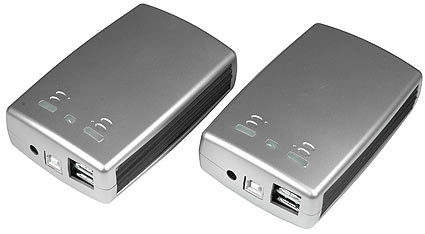Silicon Image Brings Virtualization to eSATA
Prototype SteelVine Gen. 2 Hard Drives
We received two external hard drive prototypes that both carry Silicon Images' Sil5744 storage processors.
We received two boxes that carried two different hard drives. Silicon Images calls them PDE, which stands for production, design and engineering. Basically these are external 2.5" hard drives with eSATA and USB 2.0 interfaces. The second eSATA interface is necessary to daisy-chain one drive to the next. It's also possible to attach several of these PDE drives via eSATA, and hook up the chain to a host system via USB 2.0. One PDE used a Seagate Momentus 5400.2 80 GB; the other one used a Fujitsu 80 GB 2.5" SATA hard drive.
As you will see in the benchmark section, the drives perform very much like other external hard drive products. A single SteelVine PDE drive reached a quick average access time of 16.6 ms when running on an eSATA interface. Via USB 2.0, the access time increased to 18.7 ms. Running Big, Fast or Safe modes on eSATA results in an access time that is very much in between these two results. Fast mode or Big mode delivers the same transfer rates as you can expect from a single drive. We recommend having a look at the data transfer diagrams as well; the Big mode clearly shows that two drives are simply concatenated. RAID 0 managed to effectively double the data transfer rate from 35 to 70 MB/s, which speaks for the performance of the storage processor. Typically, RAID 0 doesn't exactly achieve 2x performance.
The SteelVine architecture is pretty powerful, but the IC drives the power consumption of an external 2.5" hard drive above the level that a single USB 2.0 port can provide.
Get Tom's Hardware's best news and in-depth reviews, straight to your inbox.
Current page: Prototype SteelVine Gen. 2 Hard Drives
Prev Page SteelVine Storage Processors Gen. 2 Next Page Configuration And Operating Modes
Patrick Schmid was the editor-in-chief for Tom's Hardware from 2005 to 2006. He wrote numerous articles on a wide range of hardware topics, including storage, CPUs, and system builds.



